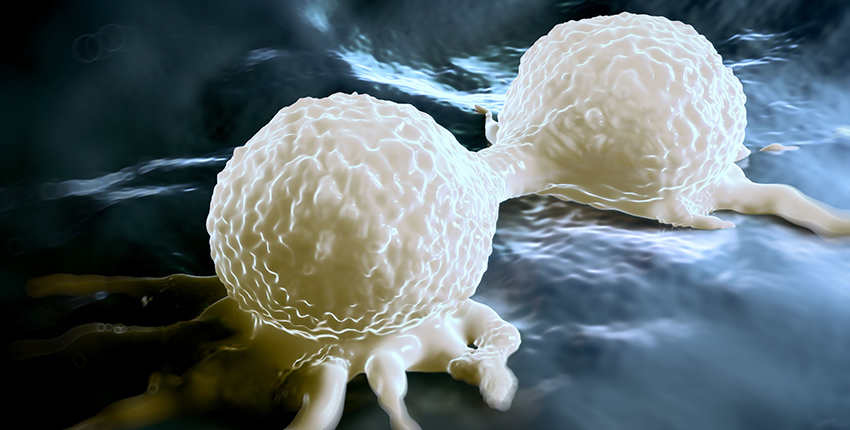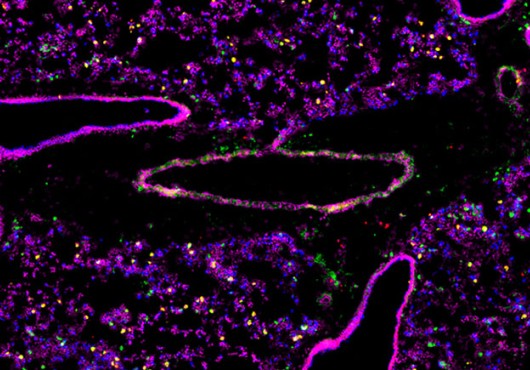
Artist’s rendition of cancer cells. Image: royaltystockphoto/iStock
Throughout his science training in Vietnam, Germany, Austria and the United States, Nam Chu has loved finding ways to fight diseases such as neurodegeneration and cancer.
“To do that,” he says, “you need to understand the underlying molecular mechanisms—how certain proteins can cause the disease and how you can intervene.”
Now a postdoctoral fellow in the lab of Philip Cole at Harvard Medical School and Brigham and Women’s Hospital, Chu has made his latest contribution by revealing that a major cancer-related protein, Akt, can take on not one but two different shapes—and that each shape responds to different cancer-fighting drugs.
“I think our findings are really exciting. I think we have helped solve a 20-year-old mystery about how this important enzyme is turned on and off,” said Chu.
The findings were published online Aug. 2 in Cell.
For more than two decades, researchers believed Akt has one activated form. “We now have to deal with the fact that there are two quite different ones,” said Cole, professor of biological chemistry and molecular pharmacology at HMS and professor of medicine at Brigham and Women’s.
Those differences could inform cancer drug development and treatment strategies.
“If Akt is activated by one mechanism, you might need drug A, whereas if it’s activated by the other mechanism, you might need drug B,” Cole said.
In sickness and in health
Also known as protein kinase B, Akt helps regulate many systems in the body, including blood sugar levels, programmed cell death, cell proliferation and cell migration.
Akt also belongs to one of the most commonly activated pathways in cancer. More than 100 clinical trials have been conducted to test Akt inhibitors—drugs that block Akt’s abnormal activity—as treatments for breast, pancreatic, lung, prostate and ovarian cancers as well as multiple myeloma, lymphoma and other cancers.
However, these trials have had mixed results, and no drugs that block Akt have been approved by the FDA, said Cole. (One drug is on the market so far that blocks PI3K, a protein in the same pathway as Akt.)
Akt’s dual identity could be a factor, the study authors said.
“Part of the reason nothing has had dramatic effect could be these different mechanisms of Akt activation” that scientists didn’t know about, Cole said.
Cole, Chu and colleagues believe their new insights could help researchers design better tailored, more effective Akt inhibitors and select the ones most likely to work for particular clinical cases.
A tale of two structures
Before the current study, researchers had identified two ways that Akt can be activated, but they thought both led to the same ultimate shape. Chu and colleagues demonstrated otherwise.
First, the team found that a short segment connecting two bigger parts of the protein, previously thought to have no purpose, was instead “absolutely crucial to how Akt is regulated,” said Cole.
Then, using specialized techniques, the team discovered that an 18-year-old model of Akt’s activated form needed some tweaking.
“That was a surprise. We didn’t believe we’d find out anything new about that well-established model,” said Cole.
In addition, the researchers found that the second model of Akt activation, developed four years ago by Wenyi Wei, HMS professor of pathology at Beth Israel Deaconess Medical Center, led to a significantly different form of the protein than expected.
Cole’s group is now collaborating with Wei’s team and with Haribabu Arthanari, assistant professor of biological chemistry and molecular pharmacology at HMS, to flesh out the details of Akt’s second form with the hope that it provides more clues about how to target it with medicines.
Gaining a deeper understanding of Akt’s second structure could also help researchers who are struggling to develop Akt inhibitors that fight cancer without a major side effect—inducing diabetes.
“Is it possible to treat cancer by targeting Akt without blocking the body’s ability to respond to insulin? This work may offer a new blueprint,” Cole said.
“It’s exciting to be here in Boston to continue to work on Akt with experts in the field,” he added.
Cole is co-senior author of the study together with Sandra Gabelli at Johns Hopkins School of Medicine, where Cole and Chu were based until they came to HMS in 2017. Chu is first author. Additional authors are based at Brigham and Women’s and the Dana-Farber Cancer Institute.
This study was supported by the National Institutes of Health (grants CA74305 and CA062924) and the FAMRI Foundation.





